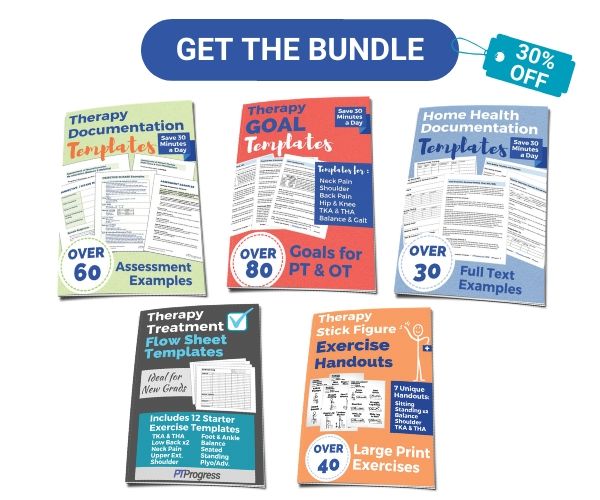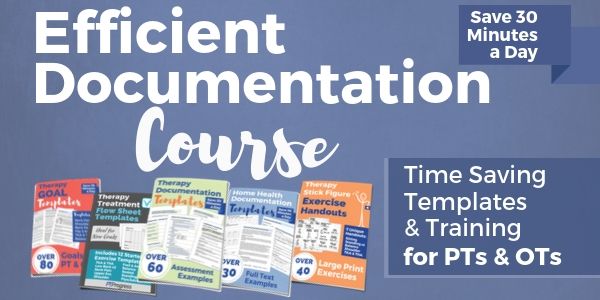The physical therapy assessment portion of a therapy note is the why behind the treatment you provided during your patient’s visit.
A great therapy assessment accomplishes two things:
- It highlights the necessity for skilled therapy
- It identifies areas to address in future treatments.
In addition, your therapy assessment documentation should include a summary of the patient’s ability (or difficulty) in performing a specific task. Relating the treatment back to a functional goal will round out an excellent assessment.
Physical Therapy Assessment Documentation Examples
You’ll find yourself writing a lot of assessments throughout your career. Most commonly, you’ll include an assessment when completing daily notes, documenting progress notes, or writing an evaluation. But no matter the occasion, the assessment component can become the most time-consuming portion of your documentation. Learning how to write efficient, effective notes early on will save you precious time.
To start, let’s look at some example therapy assessments.
Physical Therapy Assessment Example: Evaluation
A physical therapy evaluation assessment succinctly summarizes your findings and answers the question: “Why does this person need PT?”
Try following this simple outline for an evaluation assessment:
- Restate the diagnosis
- Remark on the patient’s rehab potential
- Identify their key impairments
- State why skilled PT is necessary
Evaluation Assessment Example:
Patient presents with signs and symptoms consistent with diagnosis of R Hip OA, s/p 1 week post operative R THA. Rehab potential is excellent. Key impairments include: decreased ROM and strength of the left lower extremity, poor balance and compensatory gait patterning, increased swelling, and pain with functional activities such as squatting, walking, and climbing stairs. Skilled PT is required to address these key impairments and to provide and progress with an appropriate home exercise program. This evaluation is of moderate complexity due to the changing nature of the patient’s presentation as well as the comorbidities and medical factors included in this evaluation.
Interested in the full sample evaluation? Documentation templates and evaluation examples are included in the Efficient Documentation course.
Physical Therapy Assessment Example: Daily Notes
You don’t need to write a paragraph for this type of documentation, but being too brief could diminish important aspects of your skilled assessment. Focus on the key elements you worked on in the session. If you targeted balance training, your assessment should reflect why.
It wouldn’t make sense to spend the majority of your treatment on balance and stability training but then spend the majority of your assessment writing about soft tissue restrictions. Your assessment should reflect your treatment both truthfully and proportionally.
Here are two examples of a brief daily note assessment:
- Repeated squatting was effective in reducing pain in the patient’s low back and reinforced proper body mechanics for navigating sit to-stand transfers.
This assessment statement identifies the purpose of your treatment as well as the patient’s response to your treatment. Additionally, it incorporates the functional goals you’re working towards.
- The patient lacked coordination with foot placement, which may increase risk of falling. Focused on improving proprioception and coordination with LE foot placement.
This brief assessment phrase targets a key impairment that could lead to further injury if left unaddressed. Phrases like this will clue the reader into your intentions and help your writing reflect the skilled treatment you provided.
See three tips below for how to write better documentation in less time.
3 Physical Therapy Documentation Tips

1. Comment on Improvements and/or Impairments
Stating the patient’s improvement in strength, balance, or mobility is a good use of the assessment. It’s also helpful to acknowledge areas that need continued work. Here’s an example:
- The patient is now able to ascend a 4” step, but requires the use of both hands for support.
2. Identify Response to Treatment
We’ve all seen this lazily-written phrase before: “The patient tolerated treatment well.” Seeing only this in the assessment section should make you cringe.
Rather, the report should include observations of the patient’s response, such as an ability to change movement patterns or posture, physical changes or adaptations during treatment, degrees of stability, etc. Here’s an example:
- The patient demonstrated poor upward rotation of the scapula with right shoulder flexion. Tactile cues and manual support of the scapula decreased popping in the shoulder.
3. State the Reason to Continue Therapy
Lastly, the assessment gives you an opportunity to advocate for continued care. By acknowledging current improvements, identifying remaining impairments, and stating your reason for addressing these impairments, you will make a strong case for continued therapy.
- The patient demonstrates improved balance as noted with ability to stand on a single leg for 3 seconds. However, he/she continues to lose his/her footing while ambulating on uneven surfaces. Dynamic stability training on varying surfaces should aid in the patient’s ability to safely navigate different terrains.
60+ Physical Therapy Assessment Documentation Examples
Sometimes therapists get in a “documentation rut.” After a long day of seeing patients, you may feel as if you lack the creativity to jump into “writing mode” and document the treatments you performed all day.
Without these resources, writing each note can take up to 10 minutes per patient, per day. So if you see 13 patients in a day, saving just 5 minutes on each note will reduce your daily documentation time by over 1 hour.
Besides saving you time and energy, my assessment templates will give you the inspiration you need to format and craft well-written assessments. Plus, with these 60+ therapy assessment documentation examples, you will be able to write assessments that reflect the skilled care you provide.
To optimize efficiency in your documentation, check out this bundle for both the therapy assessment templates and other documentation examples.




